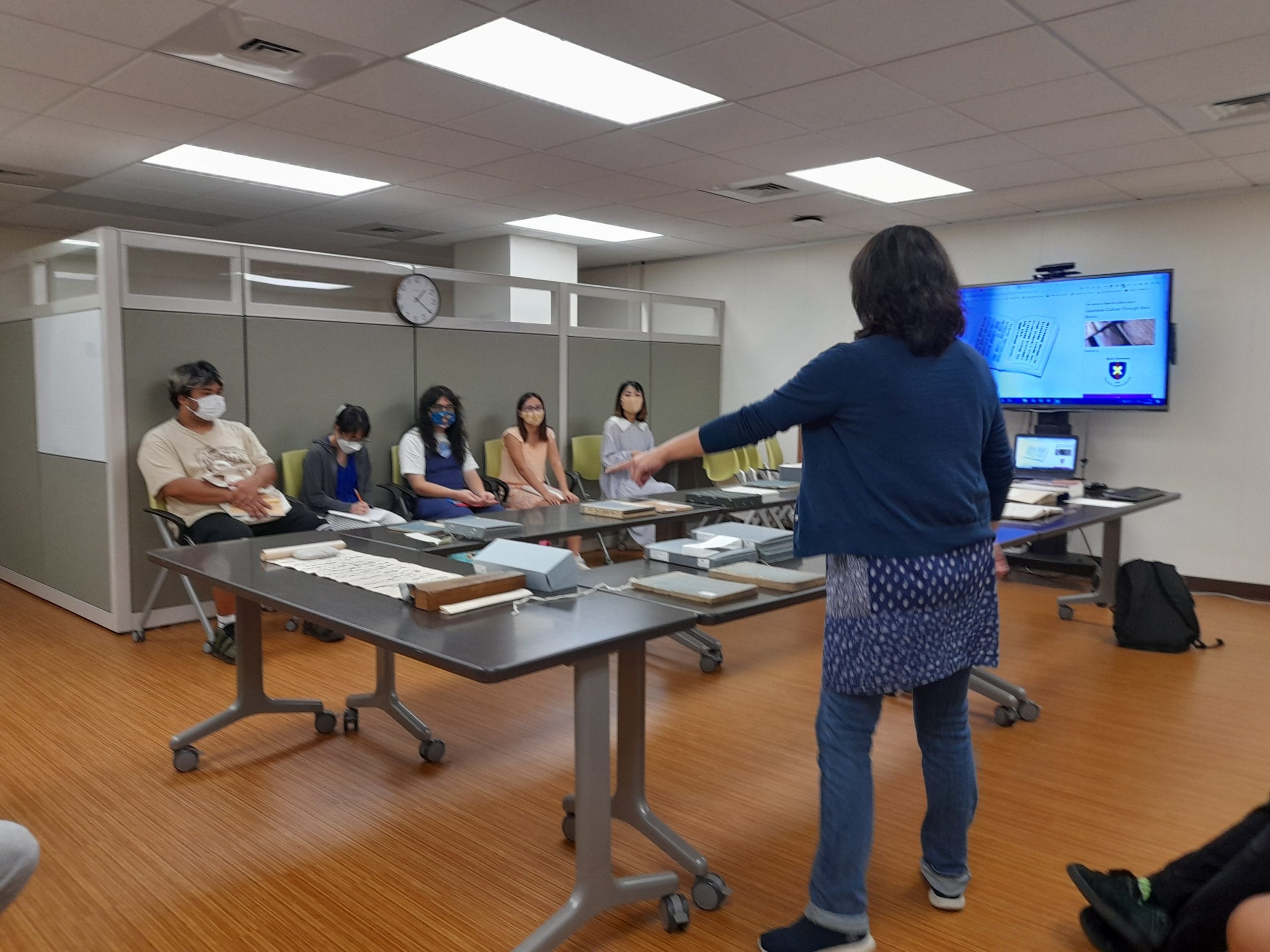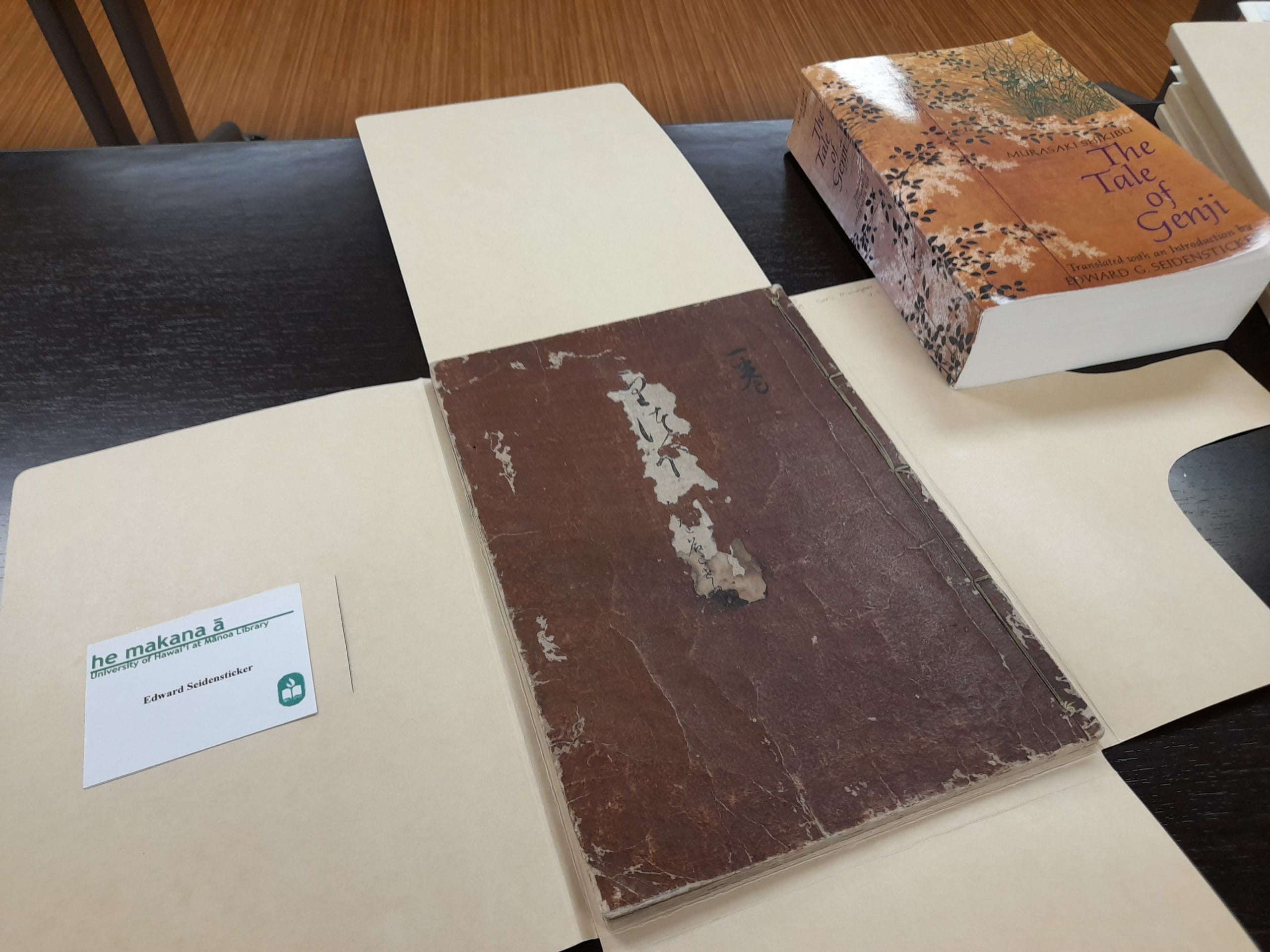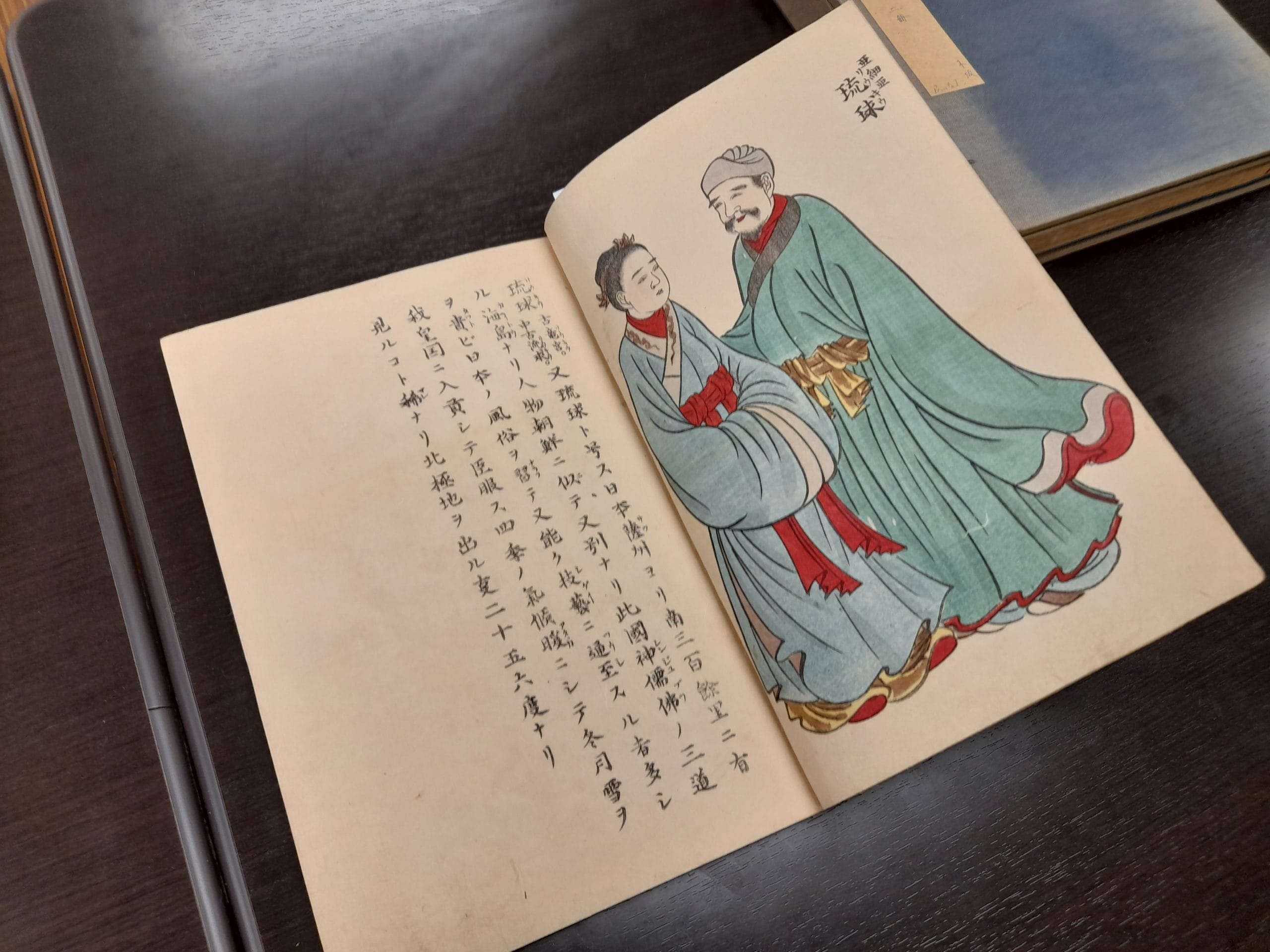On Friday, September 16, Prof. Tommasi’s “Intro to Classical Japanese” class visited the Hamilton Library to discover the treasures of the UHM Japan Special Collection, a set of pre- and early-modern materials (kotenseki 古典籍) that undergraduate students are seldom granted access to. Not only did this hands-on experience allow students to “feel the past” and gain a newfound knowledge about traditional book culture, but it also offered them a glimpse into the joys and challenges of archival research.
To engage with ancient sources, students took a “speed-dating” approach: everyone looked at a different object for 3-5 minutes on a cycle, taking notes and thinking about similarities and differences. When writing down their observations, they were asked to focus on relevant features, such as format (book-binding type, print/manuscript), paper quality (color and thickness), writing style, and text-image relationship, formulating hypotheses about the possible readership and functions of the textual artifacts. Here are some of the students’ voices and takeaways from this experience:
This experience was very special. Before this semester, I didn’t really have an appreciation for objects even a hundred years old. Witnessing how much care went into handling these books and being able to look through them myself helped me put into perspective how even everyday day objects like letters, a journal, or textbook are an important peek into how things were done then compared to today or another several centuries (or even decades!) into the future. (Monique DeLara)
It was an amazing experience to see and touch the Japanese kotenseki first hand. To take in the variety of subjects such as foreigners, famous places, whaling, and self-help presented on these materials was like stepping back in time. I liked finding out what was popular or what was happening in those time periods by what their booklets were about. You can tell a lot of effort went into the construction of these pieces since the pictures were all very detailed, with some being hand painted, and some of the printed booklets looked as if they had been handwritten. We are lucky to have these well preserved pieces of history right in our own library. (Sarah Domingo)
Visiting the Hamilton Library and being given the opportunity to view and touch some of the kotenseki was an interesting experience where we got to learn about various literature formats that were used throughout the pre-modern ages. We talked about the type of paper that was used, whether a piece was hand written or printed, and how that piece made its way to the University of Hawaii to be studied and preserved. One of the most interesting pieces were what looked like a whaling record book that used various types of paper binded together, and had hand-drawn illustrations of whales and tools that were used for whaling. (Sho Tanaka)
Even though I learned koten [i.e., the classics] in Japan, I’ve never seen actual materials, how it is composed, how it looks, and how the actual difference in each era. Seeing actual physical material and feeling them through my hands gave me a re-think about classical Japanese. Each handwriting even it was printed type was also interesting to look at and imagine how this person was because I think handwriting can show their personality. (Miyu Kiriya)
It was a very fascinating visit to the rare materials. Being able to actually feel the materials with my own fingers is an extraordinary experience. The most shocking thing I found about the Japanese kotenseki is the quality and techniques of printing. I was so surprised when the catalogist said that some of the seemingly handwritten manuscripts are actually printed. It is impossible to tell the differences except for the fukurotoji [i.e., “bound-pocket” or “pouch”] binding method. The 50 minutes felt rather short. (Zi Ye)
Classical Japanese is something unfamiliar to me, and having the chance to observe and learn Japanese kotenseki was really exciting. It was really cool to compare the different forms of Japanese kotenseki, like estimating when they were published, and how to distinguish between handwritten and printed collections. I am so glad for this rare opportunity, and would love to cherish it. (Marcy Tokunaga)
Getting to experience the special collection of kotenseki was an experience completely unlike any I’ve had before! Learning about classical Japanese is always an enlightening experience, but sometimes it feels difficult to connect with material so distant from the present. Being able to see how it was actually used, in letters, manuscripts, diaries, and informative guides, really impressed on me the point that this was a language that once lived and breathed and was used by people in their daily lives and thus, is a part of history and needs to be studied to fully understand the past. It was also fantastic to be able to see materials that stretched over a good portion of recorded Japanese literary history, as it drove home the point that classical Japanese was in fact used until fairly recently and thus, in that way, can form a bridge between the past and the present. I am extremely thankful to receive this rare opportunity to interact with the kotenseki physically! (Rui Kono)
We had a very valuable experience with handling literature that cannot be found anywhere else in the world. The preservation of each material was incredibly high with no issues on reading and observing the original texts which are written. Being able to physically touch the pieces was something that I would have probably never had the chance to do unless I was in this class. Just knowing that I am in contact with something that has essentially time traveled is a very magical feeling, as well as thinking of the past individuals which have handled these pieces. Learning about the history was quite interesting as well, how the books are written, how they are illustrated, and the different uses each of them had. I also enjoyed how different shapes the written forms can come in. Some were scrolls, others were books, paper bindings, and even a letter in a frame. I think the collection does a good job showcasing the different works, it was very intriguing. (Shun Mizuno)
A heartfelt mahalo to our fantastic library staff, particularly Sachiyo Kawaiʻaeʻa, for arranging the room and guiding us through the marvels of book cataloging and preservation techniques. This “kotenseki project” will continue over the next couple of months with the exploration of another important Hawaiian collection of Japanese antiques at the Honolulu Museum of Art—a valued partner of the UH community. Stay tuned for more details!
For more information on this project, please contact Dr. Pier-Carlo Tommasi at tommasi@hawaii.edu.




